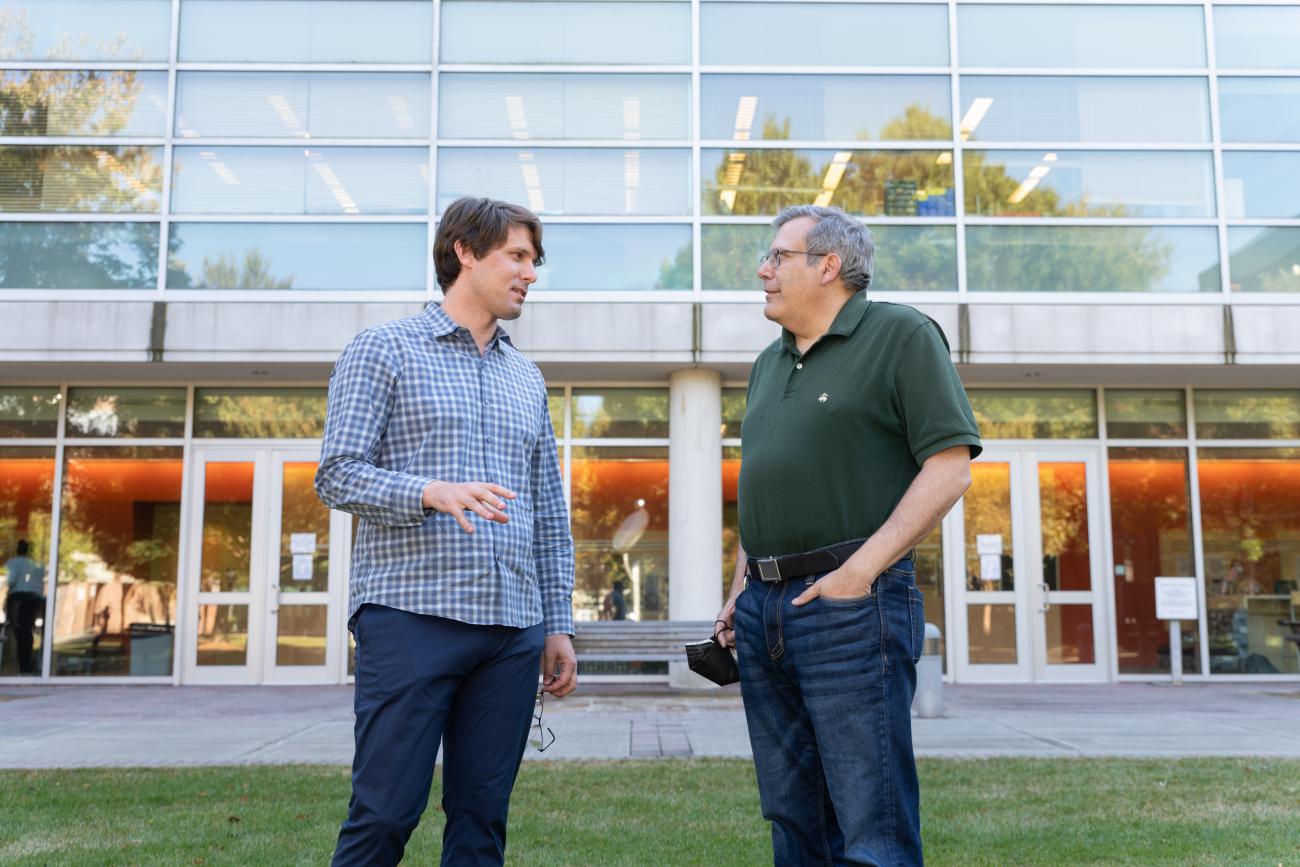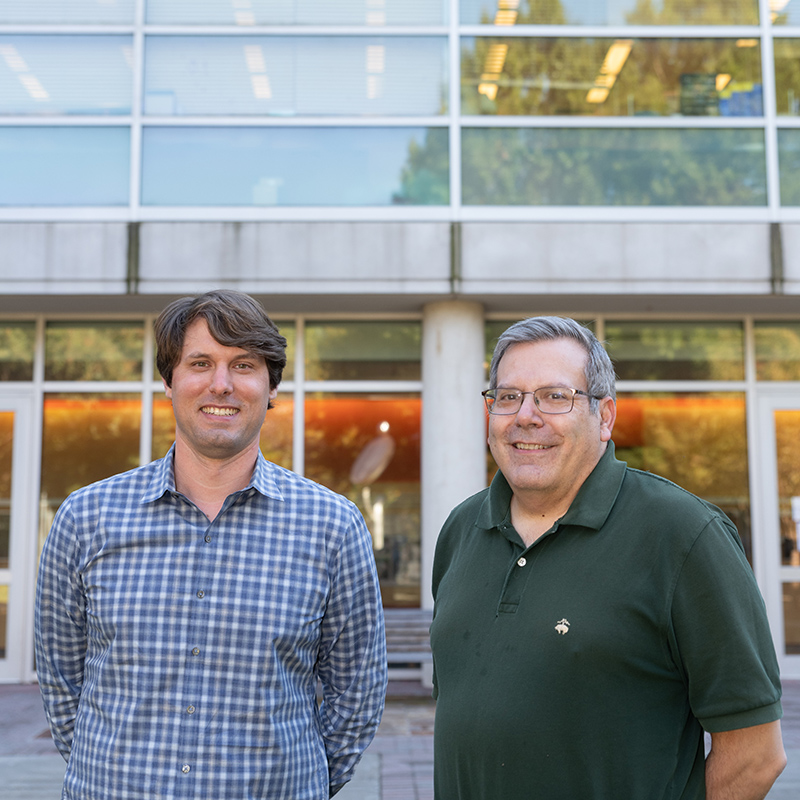‘Species agnostic’ screening is the latest result of a powerful partnership between James Dahlman and Phil Santangelo
By Jerry Grillo
James Dahlman and Phil Santangelo are helping to define an evolving era in medicine, one in which messenger ribonucleic acid — mRNA — can be delivered directly to cells to fight against disease. And their latest groundbreaking study could clear the way to faster therapeutic discoveries.
Long before the Covid-19 pandemic put a global spotlight on mRNA-based vaccines, these two researchers in the Wallace H. Coulter Department of Biomedical Engineering at Georgia Tech and Emory University were combining their distinct skillsets to leverage the clinical potential of mRNA.
“Our work is very compatible,” said Dahlman, associate professor and McCamish Foundation Early Career Professor. “Phil’s lab designs and manufactures really high-quality mRNA, and my lab develops the lipid nanoparticles to deliver it.”
Therapeutics made from mRNA or DNA hold promise in addressing lots of diseases, explained Santangelo, a professor in Coulter BME, “but they’re not much good if they can’t get where they need to go. If you make cargo, which is essentially what we do in my lab, you need delivery, so James and I have a very natural collaboration.”
Their partnership, which began when Dahlman arrived at Georgia Tech in 2016, consistently yields results published in high-impact journals and garners generous research grants from federal agencies, including the National Institutes of Health (NIH) and the Defense Advanced Research Projects Agency (DARPA).
That includes a recent flood of cutting-edge papers: two in Nature Biomedical Engineering (from October 2021, and a forthcoming study) as well as their latest publication, released Feb. 7 in Nature Nanotechnology.
“We’re reporting an improved barcoding system that would make animal pre-clinical nanoparticle studies more predictive, speeding up the development of RNA therapies,” Dahlman said.
Several years ago, Dahlman and collaborators developed a technique called “DNA barcoding,” which allows for the rapid, simultaneous screening of many of his custom-made delivery vehicles — what are called lipid nanoparticles, or LNPs. Scientists insert unique snippets of DNA into different LNPs, which are injected into mice. Genetic sequencing is then used to determine which barcodes have reached which specific targets.
The new system described in Nature Nanotechnology takes the screening process a step further.
“Lipid nanoparticles are usually developed in mice, but when you move them into another species, like a non-human primate — because that’s the natural progression, a primate is more like a human — they frequently don’t work as well,” Santangelo said. “When they don’t, you have to go back and make adjustments.”
But what if you could streamline the process?
The genes that affect LNP delivery vary between pre-clinical species and humans, though the extent of those differences is unknown because studies comparing nanoparticle delivery across species have been very difficult to perform. Until now. To speed that process, the researchers developed a new testing system they’re calling Species Agnostic Nanoparticle Delivery Screening, or SANDS.
Using SANDS, the team compared nanoparticle delivery simultaneously in mouse, primate, and living human cells, all within specially engineered mice.
“We can actually put the same group of nanoparticles in all three and compare delivery across species,” Dahlman said. “We found what you might expect: delivery in the primate cells predicted really well how delivery in the human cells would go, whereas the mouse cells were less predictive.”
Unlike the previous barcoding system, which worked well in mouse cells, SANDS needed a different kind of marker for screening, a molecule called reporter mRNA. Santangelo’s lab developed one, “and it basically gets around the limitations of the old system,” he said. “Now we can screen new lipid nanoparticles in mice with primate and human cells.”
SANDS already is facilitating further studies for the research team.
Going forward, Dahlman and Santangelo believe that deeper understanding of the different mechanisms driving delivery in mouse cells and other cells will result in a more efficient selection process for LNPs, making pre-clinical nanoparticle studies more predictive and accelerating the development of RNA therapies.
That sense of building momentum has been kind of a theme for the Dahlman-Santangelo partnership since it began. Dahlman remembered interviewing at Georgia Tech and Emory and being immediately impressed when he met Santangelo.
“I explained to him my vision for barcoding, and he immediately got it; he explained to me his vision for improving payloads, and I immediately got that,” Dahlman said. “You could have the world’s best nanoparticle, but if you don’t put optimized mRNA in it, that’s not going to be any good.”
They immediately recognized the value and the necessity for collaboration, especially because, as Santangelo put it, “This is a wildly competitive time in mRNA research.”
The pace of their work reflects that, too. Their October study in Nature Biomedical Engineering reported development of an LNP designed specifically to be delivered by a nebulizer into the lungs. In their experiments, it successfully delivered therapeutic mRNA and protected mice from a lethal flu. They’ve got several more papers nearing publication.
And there’s work soon to be funded by the Wellcome Leap program that includes a project focused on mRNA-encoded antibodies for the lung. They’re also developing what could be another game-changer in vaccinations — what Santangelo described as “a new type of approach that has a lot of potential: The basic idea is to have the ability to vaccinate against many pathogens at once.”
Ultimately, though, it comes back to having the best vehicle to deliver the potent payload; you can’t really have one without the other. The Dahlman-Santangelo research partnership is complementary in other ways as well, with Dahlman’s lab doing a lot of the sequencing and Santangelo’s lab doing a lot of the imaging.
“It means that we can write papers that are much more complete,” Santangelo said. “It includes all of the data, and it can have sequencing, it can have imaging, it has fancy cargoes, it has cool delivery. You put together all of those pieces, and you have a nice package.”
Latest BME News
Jo honored for his impact on science and mentorship
The department rises to the top in biomedical engineering programs for undergraduate education.
Commercialization program in Coulter BME announces project teams who will receive support to get their research to market.
Courses in the Wallace H. Coulter Department of Biomedical Engineering are being reformatted to incorporate AI and machine learning so students are prepared for a data-driven biotech sector.
Influenced by her mother's journey in engineering, Sriya Surapaneni hopes to inspire other young women in the field.
Coulter BME Professor Earns Tenure, Eyes Future of Innovation in Health and Medicine
The grant will fund the development of cutting-edge technology that could detect colorectal cancer through a simple breath test
The surgical support device landed Coulter BME its 4th consecutive win for the College of Engineering competition.









